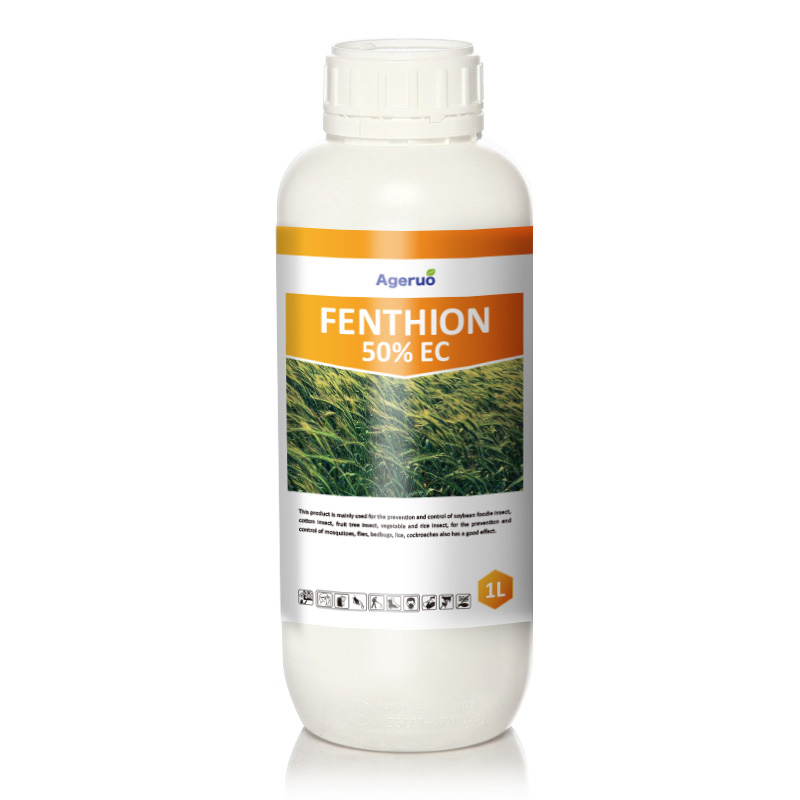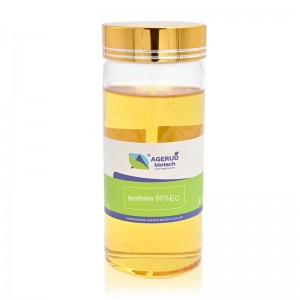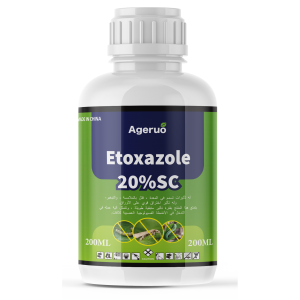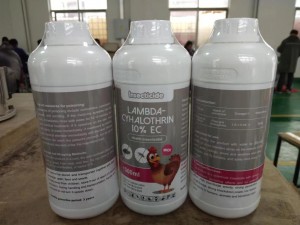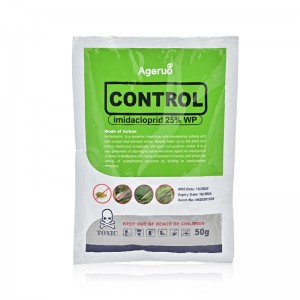Products
POMAIS Insecticide Fenthion 50% EC
Introduction
| Active ingredients | Fenthion |
| CAS Number | 55-38-9 |
| Molecular Formula | C10H15O3PS2 |
| Classification | Insecticide |
| Brand Name | POMAIS |
| Shelf life | 2 Years |
| Purity | 50% EC |
| State | Liquid |
| Label | Customized |
| Formulations | 50% EC |
Mode of Action
Fenthion is a fast-acting organophosphate insecticide that works by inhibiting the enzyme acetylcholinesterase (AChE) in the nervous system of insects. This inhibition leads to the accumulation of acetylcholine at nerve synapses, disrupting normal nerve signal transmission. The result is overstimulation, paralysis, and ultimately death of the insect.
Unlike purely contact-based insecticides, Fenthion combines contact toxicity, stomach poisoning, and limited systemic activity, making it highly versatile across pest types and crops.
Key Mechanisms:
-
Contact Kill: Immediate knockdown when insects come into direct contact with the spray
-
Stomach Poison: Ingestion leads to neurotoxic effects, particularly effective against chewing pests
-
Translaminar Activity: Partial movement through leaf tissue enhances control of pests hidden on the undersides
-
Residual Action: Offers extended protection for several days after application, reducing frequency of use
Targeted Insect Nerve System:
Fenthion binds irreversibly to acetylcholinesterase enzymes, causing neuromuscular disruption. This broad-spectrum neurotoxicity makes it suitable not only for field pests but also for public health insects such as mosquitoes, flies, cockroaches, and lice.
By leveraging this well-established mode of action, Fenthion is a reliable choice for resistance management programs and integrated pest control in both agriculture and urban hygiene scenarios.
Target Pest Spectrum & Crop Applications
Fenthion 50% EC offers effective pest control across agricultural, horticultural, and public health settings. Its contact and stomach toxicity makes it especially suitable for controlling a wide range of insect pests, including both chewing and sucking species. With rapid knockdown and reliable residual activity, this formulation supports intensive crop production and vector control programs.
Key Target Pests Controlled
-
Aphids on vegetables and leafy crops
-
Budworms and borers on soybean, cotton, and fruit trees
-
Suction pulp worms in cereals like wheat
-
Mosquitoes, flies, bedbugs, and lice in public health scenarios
-
Cockroaches in storage and sanitation-sensitive areas
Recommended Crop Applications
| Crop | Target Pest | Formulation | Dosage | Application Method |
|---|---|---|---|---|
| Wheat | Suction pulp worm | 50% EC | 746–1493 mL/ha | Foliar spray |
| Soybean | Budworm | 50% EC | 1791–2388 mL/ha | Foliar spray |
| Brassica vegetables | Aphid | 50% EC | 597–896 g/ha | Foliar spray |
Public Health and Vector Control
| Environment | Target Pest | Formulation | Dosage | Application Method |
|---|---|---|---|---|
| Outdoor areas | Mosquitoes | 5% GR | 20 g/m² | Granule broadcast |
| Domestic/commercial | Flies, cockroaches | 50% EC | As per label | Space or spot spraying |
| Residential spaces | Bedbugs, lice | 50% EC | As per label | Direct spray or wipe-on |
Fenthion is a practical option for multi-sector distributors, offering a single solution adaptable to field crops, urban hygiene programs, and mosquito vector management. This versatility helps reduce inventory costs while improving market coverage.
Suitable crops:

Act on these Pests:

Usage Guidelines & Application Timing
To achieve optimal efficacy and crop safety, Fenthion 50% EC must be applied at the correct dosage and growth stage. As a contact and stomach poison, the product works best when directly targeting pests during active feeding stages. Application timing and method vary depending on the crop, pest type, and formulation.
Application Method by Crop Type
-
Cereal Crops (e.g., Wheat): Apply at the early infestation stage of suction pulp worms. Ensure uniform foliar coverage and avoid application during strong sunlight or rain.
-
Soybeans: Budworm control is most effective when larvae are in early instar stages. Use high-volume spraying equipment for dense crop canopies.
-
Vegetables (e.g., Cabbage, Mustard, Radish): Target aphid infestations during their population build-up phase. Repeat application may be necessary after 10–14 days depending on pest pressure.
-
Public Health Areas: For mosquitoes and flies, apply granules evenly over breeding grounds or spray emulsifiable concentrate on resting surfaces in accordance with local regulations.
General Application Guidelines
| Formulation | Recommended Dilution | Frequency | Precaution |
|---|---|---|---|
| 50% EC | 500–1500 mL per hectare | 1–2 applications per season | Avoid overlap with similar organophosphates |
| 5% GR | 20 g/m² (for mosquito control) | As needed, based on monitoring | Avoid applying near aquatic environments |
Best Practices
-
Always apply during early morning or late afternoon to reduce evaporation and maximize uptake.
-
Use fine mist nozzles or high-pressure sprayers for even distribution on foliage.
-
For public health applications, coordinate with local authorities to comply with safety and exposure limits.
-
Maintain personal protective equipment (PPE) during handling and application.
By aligning your application strategy with crop phenology and pest behavior, Fenthion 50% EC can provide cost-effective, high-impact pest suppression, supporting yield protection and environmental compliance.
Public Health & Vector Control Applications
Beyond agricultural usage, Fenthion 50% EC plays an important role in public health pest management. Due to its fast knockdown and long residual activity, it is widely applied for mosquito, fly, bedbug, lice, and cockroach control in outdoor and semi-enclosed environments.
Key Application Scenarios:
-
Urban Vector Control: Used by municipal and commercial pest control operators to reduce populations of mosquitoes and flies in public parks, drainage zones, and stagnant water areas.
-
Outdoor Areas: Applied in recreation zones, construction sites, and garbage disposal areas for effective control of disease vectors.
-
Housing Facilities & Animal Shelters: Used to eliminate lice and cockroach infestations where sanitation risks are high.
Public Health Use Advantages:
-
Rapid Contact Kill: Acts quickly on adult pests, reducing the need for repeat applications.
-
Flexible Application Forms: Available in EC for surface spraying and GR for ground broadcasting.
-
Cost-Effective Coverage: Lower application volumes required compared to pyrethroid-based alternatives.
-
Integrated Vector Management (IVM): Can be used as part of rotational programs with larvicides and repellents to prevent resistance build-up.
Application Reference:
| Target Pest | Recommended Area | Formulation | Dosage | Method |
|---|---|---|---|---|
| Mosquito | Outdoor drainage zones | 5% GR | 20 g/m² | Granule broadcast |
| Fly | Animal shelter surroundings | 50% EC | 1:1000 dilution | Surface spray |
| Bedbug/Lice | Housing or bedding areas | 50% EC | 1:800–1000 | Spray/fogging |
Fenthion's inclusion in public health programs demonstrates its broad utility and reliability for professionals seeking both agricultural and non-agricultural solutions.
Resistance Management & Rotation Strategy
To minimize the risk of pest resistance development, Fenthion should be integrated into a well-designed insecticide rotation program. As an organophosphate, it can be alternated with other chemical classes such as pyrethroids, neonicotinoids, and carbamates. Avoid repeated applications of Fenthion within the same season, especially on pests known for rapid resistance development like aphids and budworms. For best results, combine with cultural and biological practices in an IPM (Integrated Pest Management) framework.
Key Tips:
- Rotate with products that have different modes of action (MoA).
- Limit total applications per season based on local guidelines.
- Monitor pest populations and apply only when economic thresholds are reached.
Compatibility with Other Agrochemicals
Fenthion 50% EC is compatible with most commonly used insecticides, fungicides, and foliar fertilizers. However, physical compatibility should always be confirmed by a small-scale jar test before tank mixing. Avoid mixing with strongly alkaline products, as this may reduce efficacy.
Typical Compatible Mixes:
- Fungicides: Mancozeb, Propiconazole, Thiophanate-methyl
- Insecticides: Lambda-cyhalothrin, Imidacloprid, Cypermethrin
- Fertilizers: Micronutrient foliar sprays with neutral pH
Maintain continuous agitation during spraying to prevent formulation separation.
Environmental Behavior & Residual Impact
Fenthion exhibits moderate persistence in the environment, offering a residual effect that lasts 5–10 days depending on temperature, rainfall, and crop type. It degrades mainly through photolysis and microbial action. In soil and aquatic systems, its half-life is influenced by pH and organic matter levels. Proper buffer zones should be maintained when applying near water bodies.
Environmental Highlights:
- Rapid degradation under sunlight (photolysis)
- Moderate water solubility and low bioaccumulation
- Avoid drift to non-target areas, especially pollinator habitats
Packaging Specifications & Customization Services
We offer Fenthion 50% EC in a range of packaging options tailored for bulk orders and distribution needs. All packaging complies with international transport regulations and labeling requirements.
Standard Packaging:
- 100ml / 250ml / 500ml / 1L bottles
- 5L / 20L HDPE drums
- Customized label, bottle shape, and box design available
OEM/ODM Support:
- Multilingual labels and user instructions
- Custom concentration and formulation service
- Flexible Minimum Order Quantity (MOQ) to support new brands
Comparison with Alternative Actives
Fenthion offers a balance of fast knockdown and moderate residual activity, making it a preferred option for short-cycle pests. Compared with other actives:
| Active Ingredient | Mode of Action | Knockdown Speed | Residual Effect | Broad-Spectrum | Cost Efficiency |
|---|---|---|---|---|---|
| Fenthion | Organophosphate (AChE inhibitor) | Fast | Medium | Yes | High |
| Parathion-methyl | Organophosphate | Very Fast | Short | Limited | Medium |
| Malathion | Organophosphate | Moderate | Short | Yes | Low |
| Lambda-cyhalothrin | Pyrethroid | Very Fast | Short–Medium | Yes | Medium |
| Imidacloprid | Neonicotinoid | Slow–Moderate | Long | Yes | High |
Regulatory & Safety Compliance
POMAIS ensures that Fenthion 50% EC complies with international pesticide regulations, including safety data sheet (SDS) standards, labeling, and transport classification.
Compliance Overview:
- FAO and WHO-recommended specifications where applicable
- UN Classification: UN3018, Class 6.1 (Toxic substances)
- ISO 9001:2000 Certified Production
- REACH compliance for applicable markets
Always follow local laws and guidelines for application, PPE use, and storage requirements.
Storage & Handling Guidelines
Fenthion should be stored in its original, sealed packaging in a cool, dry, well-ventilated area away from direct sunlight and sources of ignition. Always keep out of reach of children and uninformed personnel.
Storage Instructions:
- Store between 0°C and 30°C
- Keep away from food, animal feed, and water sources
- Use proper PPE (gloves, masks) during handling
Market Suitability by Region
Fenthion 50% EC is widely used in tropical and subtropical regions due to its fast knockdown and adaptability. Ideal for use in:
- Africa & Middle East: Mosquito and fly control, cotton and vegetable protection
- Southeast Asia: Rice pest control, especially for planthoppers and borers
- South America: Soybean, fruit trees, and maize pest protection
POMAIS provides full registration support documents and localized formulation guidance to support your market entry.

